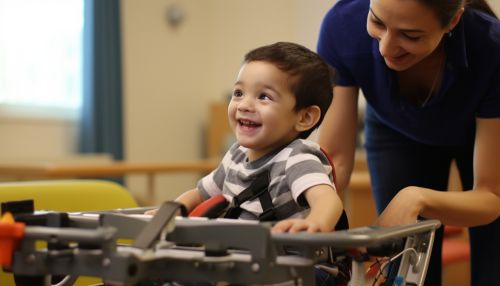Cerebral Palsy
Overview
Cerebral palsy (CP) is a group of permanent movement disorders that appear in early childhood. Signs and symptoms vary among people and over time. Often, symptoms include poor coordination, stiff muscles, weak muscles, and tremors. There may be problems with sensation, vision, hearing, swallowing, and speaking. Often, babies with cerebral palsy do not roll over, sit, crawl or walk as early as other children of their age. Other symptoms include seizures and problems with thinking or reasoning, which each occur in about one-third of people with CP. While symptoms may get more noticeable over the first few years of life, underlying problems do not worsen over time.


Causes
Cerebral palsy is caused by abnormal development or damage to the parts of the brain that control movement, balance, and posture. Most often, the problems occur during pregnancy; however, they may also occur during childbirth or shortly after birth. Often, the cause is unknown. Risk factors include preterm birth, being a twin, certain infections during pregnancy such as toxoplasmosis or rubella, exposure to methylmercury during pregnancy, a difficult delivery, and head trauma during the first few years of life, among others. About 2% of cases are believed to be due to an inherited genetic cause. A number of sub-types are classified based on the specific problems present. For example, those with stiff muscles have spastic cerebral palsy, those with poor coordination have ataxic cerebral palsy, and those with writhing movements have athetoid cerebral palsy. Some individuals may have symptoms of more than one type.
Diagnosis
Diagnosis of cerebral palsy is typically made based on the child's development over time. Blood tests and medical imaging can be used to rule out other possible causes. CP is classified into four main types — spastic, dyskinetic, ataxic, and mixed cerebral palsy — based on the type of movement disturbances. A fifth type, hypotonic cerebral palsy, is not officially recognized as a type of CP, but is often used as a term to describe decreased muscle tone. Early signs of cerebral palsy usually appear before 3 years of age. Infants with CP are usually slow to reach developmental milestones such as rolling over, sitting, crawling, smiling, or walking.
Management
There is no known cure for cerebral palsy. Management usually involves a team of healthcare professionals including physiotherapists, occupational therapists, speech therapists, and physicians. Medications such as diazepam, baclofen, and botulinum toxin may help relax stiff muscles. Surgery may be done to improve mobility and lessen spasticity. Physical therapy, occupational therapy, speech therapy, and targeted exercises may also be beneficial. Some affected children can achieve near normal adult lives with appropriate treatment. While alternative therapies are frequently used, there is no evidence to support the use of hyperbaric oxygen therapy, chiropractic manipulations, or special diets.
Epidemiology
Cerebral palsy is the most common movement disorder in children. It occurs in about 2.1 per 1,000 live births. Cerebral palsy has been documented throughout history, with the first known descriptions occurring in the work of Hippocrates in the 5th century BCE. Various efforts in the 20th century have led to improvements in care and survival.
